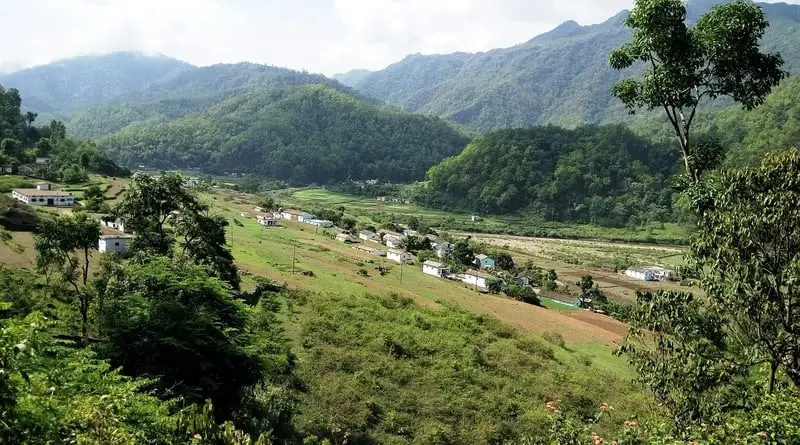Deep within the foothills of the majestic Himalaya, where the mighty mountains gracefully meet the fertile plains, lies a unique land known as Bhabar. Defined as a narrow belt of coarse sediments deposited by Himalayan rivers, Bhabar stretches from east to west across the northern Indian states of Uttarakhand and Himachal Pradesh. The term “Bhabar” itself holds an intriguing etymology, derived from the Sanskrit word “bhabra,” meaning “porous” or “gravelly,” aptly reflecting the region’s characteristic porous soil composition.
Geographical Features
Envision Bhabar as a natural bridge, seamlessly connecting the rugged grandeur of the Himalayas with the expansive flatlands of the Indo-Gangetic Plain. This geographically significant terrain typically extends 8-16 kilometers in width, forming a distinct zone between the Shivalik foothills and the Bhangar plains. Its physical characteristics are defined by its gently sloping gradient, allowing the swift, sediment-laden Himalayan rivers to lose their velocity as they enter the plains. This drop in speed results in the deposition of coarser sediments like pebbles, boulders, and gravel, creating the characteristic porous alluvial apron that defines Bhabar.
Formation and Composition
The story of Bhabar’s formation begins with the relentless work of nature. As Himalayan rivers, laden with sediments eroded from the mountains, enter the foothills, their velocity decreases due to the gentler terrain. This loss of speed causes the heavier, coarser sediments to be deposited first, forming the Bhabar belt. This deposited material primarily consists of pebbles, boulders, and gravel, interspersed with finer sand and silt particles. This unique composition creates a highly porous soil structure, allowing rapid water infiltration and drainage, resulting in a relatively dry landscape compared to the adjacent Bhangar region.
Flora and Fauna
Despite its seemingly harsh, dry environment, Bhabar boasts a unique and diverse ecosystem. The porous soil fosters the growth of drought-resistant vegetation, primarily dominated by thorny shrubs and scattered trees. Common plant species include acacia, euphorbia, and sal, forming a mosaic of scrubland interspersed with savanna grassland. This unique habitat attracts a fascinating array of animals, including leopards, jackals, wild boars, and a variety of reptiles and birds. While not as densely populated with wildlife as the nearby Terai region, Bhabar serves as a crucial corridor for movement and migration of various species.
Economic Significance
Beyond its ecological significance, Bhabar plays a vital role in the economic well-being of the region. Its well-drained, nutrient-rich soil proves conducive to various agricultural practices. Farming communities extensively cultivate cash crops like sugarcane, potatoes, and cotton, contributing significantly to the local economy. Additionally, the porous nature of the soil facilitates groundwater recharging, providing a reliable source of irrigation for agricultural lands. Bhabar’s mineral wealth plays its part as well, with reserves of gravel and boulders used for construction purposes, further boosting the economic activity of the region.
Cultural Significance
Stepping beyond its economic footprint, Bhabar is deeply interwoven with the cultural fabric of the region. Major cities like Haldwani, Ramnagar, and Tanakpur lie nestled within this fertile belt, forming vibrant hubs of commerce and cultural exchange. The diverse communities inhabiting Bhabar celebrate unique festivals and traditions, reflecting their deep connection to the land and its resources. Local art forms like wood carving and weaving draw inspiration from the natural landscape and its bountiful resources. This vibrant cultural tapestry adds another dimension to the richness of Bhabar, making it a living testament to the human-environment connection.
Bhabar in Other Contexts
Interestingly, “Bhabar” also refers to a species of grass, Ischaemum angustifolium, commonly known as baib grass. Found in parts of India and Southeast Asia, this valuable fiber grass has been traditionally used for weaving mats, ropes, and even paper. This dual meaning of “Bhabar” signifies its multifaceted significance, encompassing both the unique geographical region and the versatile grass species.
Conclusion
From its porous geological composition to its resilient flora and fauna, Bhabar serves as a captivating example of nature’s intricate design. More than just a geographical entity, it holds immense economic and cultural significance for the communities residing within its limits. As we delve deeper into understanding the delicate balance of this ecosystem, we discover a treasure trove of knowledge about sustainable land management and the profound relationships between people and their environment. Recognizing the crucial role of Bhabar in maintaining natural equilibrium and human well-being will pave the way for its responsible preservation and sustainable development for generations to come.
